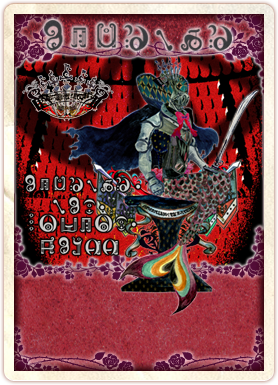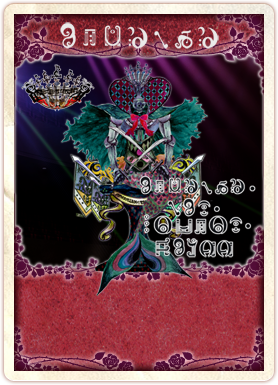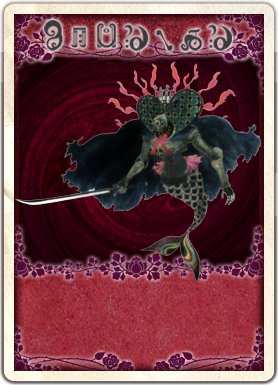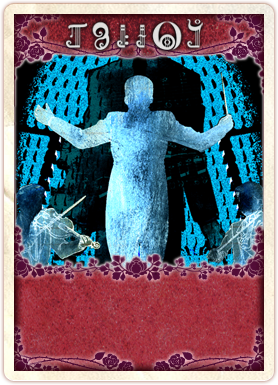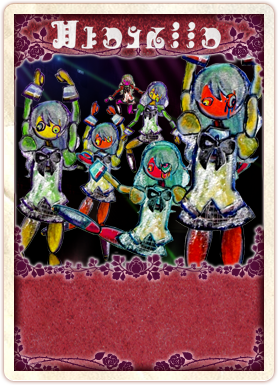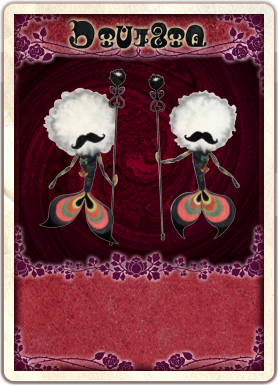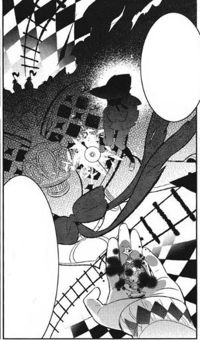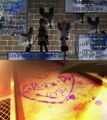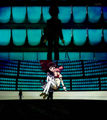Oktavia von Seckendorff: Difference between revisions
AntMan9751 (talk | contribs) No edit summary |
AntMan9751 (talk | contribs) No edit summary |
||
| Line 71: | Line 71: | ||
|name = Anthony | |name = Anthony | ||
|runes = ANTHONY | |runes = ANTHONY | ||
|image = File: | |image = File:Anthony_Rebellion_Card.png | ||
|japanese_desc = | |japanese_desc = | ||
|english_desc = Servants of the Rose Garden Witch (rental ver.). They take the role of gardeners. As they are relatively docile and numerous, as far as familiars go, the Rose Garden Witch dispatched them {{spoiler|as the main combat force for saving Homura}}. As they are under the direct command of the Mermaid Witch, the influence of her magic has changed their appearances. The medals on their chests are a treasure added by the Rose Garden Witch. | |english_desc = Servants of the Rose Garden Witch (rental ver.). They take the role of gardeners. As they are relatively docile and numerous, as far as familiars go, the Rose Garden Witch dispatched them {{spoiler|as the main combat force for saving Homura}}. As they are under the direct command of the Mermaid Witch, the influence of her magic has changed their appearances. The medals on their chests are a treasure added by the Rose Garden Witch. | ||
Revision as of 03:06, 18 December 2013
Oktavia von Seckendorff (OKTAVIA VON SECKENDORFF) is the witch form of Sayaka Miki. She briefly appears at the end of Episode 8 and battles with Kyoko Sakura in Episode 9. Her Labyrinth is filled with calls for attention -- probably to Kyousuke Kamijou. Initially, the outer areas of her Labyrinth are filled with train tracks, perhaps a reflection of the train station where she became a witch. Later on, the entrance area becomes a long corridor filled with concert posters. The center of the Labyrinth appears to be a distorted concert hall, where the seats fill the domed ceiling. Her weapons appear to be manifested wheels, and the concert hall is populated with a spectral string orchestra.
Oktavia appears in one of the alternate timelines of Episode 10.
This section may contain major spoilers!
Please refrain from reading if you are not yet familiar with all the latest media released.
Oktavia appears again in The Rebellion Story. Sayaka Miki has gained the power to summon and control Oktavia due to being part of the Law of Cycles.
The mermaid witch; it is in her nature to fall in love. Looking for the feeling that moved her so long ago, she moves with the entire concert hall. Her fortune only turns under the weight of memories and no longer moves toward the future. Nothing will reach her any longer. She will come to know nothing more. She simply allows no one to disturb her minions' playing. | |||||||||||
The mermaid witch. Her nature is to fall in love. The witch continues to dream of a guitar resounding in the middle of a concert hall, a deeply moving impression from past days. Repeating within that time with little but sure differences, her wheels of fate move around calmly. | |||||||||||
The Mermaid Witch. Once dreamt of love. This witch was cut loose once again from a part of the Law of Cycles. Unlike the Dessert Witch, the human and witch's body can act independently. She can appear anywhere as long as there is water. | |||||||||||
Minions
The mermaid witch's minion, whose duty is to perform. Several of them form a hollow orchestra that continually plays music for the witch. People who listen to their music for long enough will lose their soul. This orchestra only exists for its witch; to her, the orchestra is everything. | |||||||||||
The mermaid witch's minion, whose duty is a backup dancer. She only exists to dance cheerfully behind the witch. Klarissa's appearance is oddly similar to Hitomi. | |||||||||||
Servants of the Rose Garden Witch (rental ver.). They take the role of gardeners. As they are relatively docile and numerous, as far as familiars go, the Rose Garden Witch dispatched them as the main combat force for saving Homura. As they are under the direct command of the Mermaid Witch, the influence of her magic has changed their appearances. The medals on their chests are a treasure added by the Rose Garden Witch. | |||||||||||
Observations and Facts
- Sayaka's witch name is Oktavia von Seckendorff. Karl Siegmund von Seckendorff was a German poet who wrote a book called "The Wheel of Fate" (Das Rad des Schicksals), and could explain Sayaka's wheel attack.
- Seckendorff was also the name of a Frankish knight from a noble family.
- Oktavia is the German form of the latin name Octavia which means "the eighth" (child, month or musical interval) or "from the family Octavia". It is the direct root of octave in English (an octave being the eight interval of a scale). The name was most likely chosen because of the link between Sayaka and music.
- It might also reflect how her first appearance was in episode eight.
- The entrance to her barrier has the sayings Love Me Do, which is, incidentally, a Beatles song.
- In Episode 9 when Kyouko is shown to pass through Sayaka's barrier, it is shown that when Oktavia shouts, a distorted scream is also heard and is known to be Sayaka's voice. This most likely meant Sayaka wanted to express her feelings but she could not because of her broken state. As seen before her transformation to be a witch, she had issues speaking to Kyouko. With her life reaching its end, she could not help herself in the situation.
- Oktavia's barrier shows rail tracks (as well as wheels, that may be there for the same reason), what is possibly due to what Sayaka heard from two men in the train right before she turned into a witch.
- Holger is a Scandinavian masculine given name derived from the Old Norse name Hólmgeirr, the prefix hólmr meaning "island", and the suffix geirr meaning "spear". It is most common amongst Danish people. [1]
- ‘Herr Holger’ is an old Swedish song [2] performed by the dark folk band Garmarna. Its central character, Sir Holger, gets beheaded for his crimes and buried, but then turns undead and goes back to his wife to warn her against going to Hell. Yet the lady won't listen to the warning: ‘Go to Hell with your squires, … And I will follow with my maidens’.
- The specific runic font used for Oktavia and Holger's cards resembles musical instruments and notation.
- One of the alternate timelines shown in episode 10 gives her barrier a slightly different appearance with familiars that resemble Hitomi. Some design documents also indicate that Kamijou is a guitarist rather than a violinist in the alternate timeline.
- Oktavia appears in all timelines in which Sayaka makes a contract.
- In the beginning of episode 9 near the name of the witch, there are floating notes of "Symposium Magarum"
- The Movie version has new runes, in it Oktavia's barrier has runes that read, "Desiderantes Affectibus": Summis desiderantes affectibus (Latin: "Desiring with supreme ardor") was a papal bull issued by Pope Innocent VIII on December 5, 1484. The bull was written in response to the request of Dominican Inquisitor Heinrich Kramer for explicit authority to prosecute witchcraft in Germany, after he was refused assistance by the local ecclesiastical authorities. The bull recognized the existence of witches.
- The bull, which synthesized the spiritual and the secular crimes of witchcraft, is often viewed as opening the door for the witchhunts of the early modern period.
Oktavia in Kazumi Magica
Oktavia is briefly shown in Kazumi Magica as background when Juubey explains how a magical girl becomes a witch.
Speculations
Please keep in mind that they are fanmade theories, and not official material.
- The runic font doesn't seem to exist in the "real world". Ergo, the strange posters that bear runic text in Episode 8 may have been a "telltale sign" of the beginning of Sayaka's Labyrinth manifestation.
- However, the musical runes appeared briefly in Episode 1 when Madoka and Sayaka were trapped in Gertrud's barrier.
- During Kyouko and Madoka's confrontation with her, a nebulous, tar-like black shadow can be seen appearing when Oktavia launches attacks. This may be a representation of Sayaka's soul now that she has become malformed, hateful witch.
- The pink ribbon is a sign of attraction, since Madoka's mother mentioned in ep 1 that wearing a pink ribbon would attract attention.
- It may though just be a transformed ribbon of Sayaka's school uniform.
- Similarities with the myth of Orion:
- "Orion was the son of the sea-god Poseidon" - the reason for Sayaka's (Oktavia's) half-fish form.
- Another reason for Sayaka's (Oktavia's) half-fish form is most likely that Sayaka herself experienced a bitter end of the story, The Little Mermaid. Sayaka saved Kyousuke; however Kyousuke is quite oblivious of this and then Hitomi confesses her feelings towards Kyousuke. This leads Sayaka into despair and she lets her own Soul Gem get corrupted. (Sayaka was told specifically by Mami that all Puella Magi had no time for relationships because they have given up their souls (meaning, they no longer can have human abilities to love a human being romantically).
- The parallels are fairly obvious between the stories: (Sakaya/Mermaid) falls in love with (a prince/Kyousuke) and decides to trade important pieces of herself (legs and tongue/soul) to the deal-maker (Sea Witch/Kyubey) in order to make a wish that she believes will win his love (being a human/healing his hands). However, because she hesitates and doesn't actively seek a relationship, (the prince/Kyousuke) goes to pair off with (the foreign princess/Hitomi); (the mermaid's sisters/Kyouko) tell(s) (Sayaka/Mermaid) to (break all Kyousuke's appendages to make him dependent on her/kill the Prince so that she can return to the sea alive), but she cannot, and through her unwillingness she (evaporates into sea foam/becomes Oktavia von Seckendorff).
- "Odysseus sees him hunting in the underworld with a bronze club" - first time we've seen Sayaka in a barrier (underworld), she carried a golden (bronze) bat.
- "he hunted with the goddess Artemis and her mother Leto" - she hunted with Madoka and Mami. Artemis is the moon goddess who has a golden bow as one of her symbols. Leto is maternity goddess, and mentor, similar to Mami's role in the series.
- "threatened to kill every beast on Earth" - kill every witch on Earth.
- "Mother Earth objected and sent a giant scorpion to kill Orion" - Kyoko appears, Kyoko's spear could refer to the scorpions spear (tail).
- "The creature succeeded, and after his death, the goddesses asked Zeus to place Orion among the constellations. Zeus consented and, as a memorial to the hero's death, added the Scorpion to the heavens as well" - After they died Sayaka's grief seed and Kyoko's Soul Gem turned into raw energy used to fuel the universe (as explained by Kyubey in episode 9;) they're literally among the stars now.
- The witch's mermaid tail may be a reference to both Hans Christian Andersen's The Little Mermaid and the story of Melusine. Goethe wrote a version of Melusine titled Die Neue Melusine or The New Melusina.
- There is a special Sayaka-centric scenario called "The Hollow Little Mermaid", from the Madoka Magica Mobage game.
- The upper part of her body wears a suit of armor and protruding from behind her tail there are also coat of arms. A strong indication or connection to its knightly roots.
- The knightly part of Oktavia's design may bear a symbolic meaning; as a magical girl, Sayaka wanted to use her powers for justice and to protect the vulnerable; such traits are often associated with knights.
- The wheels used in Oktavia's attack may also symbolize the Wheel of Fortune from tarot, whose popular interpretations include "possibilities, opportunities, new developments, sudden changes", which fit Sayaka's life from when she encountered Kyubey to when she became a Witch.
- Wheels are also commonly used as a symbol of martyrs in Christian art, as many martyrs were tortured to death by them.
- The structure of the final room may be a reflection of Miki Sayaka's subconscious.
- The shade which resembles Kyousuke is hidden under the crowded concert hall, suggesting that Sayaka does not want to admit her ambitions of owning Kyousuke's love.
- It should be noted that the Kyousuke shadow is facing away from everyone (the violin is always held in the left hand, the bow in the right). This may symbolize Kyousuke's obliviousness, and Sayaka's need for him to notice her.
- In one of other timelines, the different minions who resemble Hitomi are also killed by Witch's wheels. This might intimate that Hitomi hurt Sayaka much more in that timeline than in main timeline. (And that it is a manifestation of the witch's revenge)
- In Sayaka's route in Puella Magi Madoka Magica Portable, if Sayaka's soul gem is tainted enough, Kamijou and Hitomi badmouth her even after she saved them from witch. This pushes her into despair and become a witch. There might be a similar situation in this timeline.
- If it is true that familiars are "projections of the magical girl's heart before she became a witch.", according to the January 2012 Dengeki PlayStation, then the two different familiars may show that:
- In the anime timeline, to listen to music played by Kyousuke may be the real desire of Sayaka before she turned into a witch.
- In the alternate timeline, hatred to Hitomi might be in higher priority because she 'stole' Kyousuke.
- The Guidebook describes Oktavia's first labyrinth design as Trains with the words, "My wish is somewhere not here." (私の願いはここではないどこか). In the final scene, the magical girl kills her from behind in the first carriage, and the train derails.
- The Train design could be a reference to when Sayaka transformed into a Witch at the train station, it has been indicated that a Witch barrier is "a space resembling the magical girl's mental landscape before she became a witch."
- "My wish is somewhere not here." is a either a reference to Sayaka's real wish never been realized or that her target of desire is not within her location.
- We know Sayaka's wish, but the aformentioned "my wish is somewhere not here" could also mean that when Magical Girls turn into witches they have a last wish or desire something, and the messages from the production notes might be the last "wishes" of the magical girls before turning in previously seen witches.
- Possibly Sayaka was originally meant to die in Episode 9.
- It is speculated that Madoka used Sayaka's grief seed to cleanse Homura's soul gem after defeating Walpurgis Night in Episode 10.
- This theory is supported by similarities between the Grief Seed Madoka used and Oktavia's Grief Seed in the PSP Game.
Gallery
The barrier
The witch
- Sayaka witch.PNG
Oktavia in Episode 10.
Oktavia in The Rebellion Story.
The familiars
Official Art
- Production note Oktavia.jpg
- Production note Oktavia barrier.jpg
- PN 30.jpg
- PN 76.jpg
Speculation
Fanart
This section contains fanart images
Everything in the following fan gallery is created, or the comments accompanying them are created, for entertainment value and should not be confused with actual canon events of the Puella Magi franchise.- Fan artwork oktavia.jpg
A fan's illustration of Oktavia
- 25401962.jpg
- Oktavia fanart cool.jpg
- Sayaka mermaid fanart.jpg
- Sayaka mermaid painting fanart.jpg
- Oktavia sayaka hitomi familiars KLARISSA fanart.png
- Oktavia with sayaka fanart.jpg
- Oktavia fanart pose portrait.jpg
- Kyouko vs oktavia fanart monochrome.jpg
- Sayaka oktavia eyepatch fanart.jpg
- Sayaka mermaid knight fanart.jpg
Oktavia in human form as a mermaid knight.
- 25323945.jpg
- Sayaka looking awesome Oktavia persona crossover fanart.jpg
- 25335771.jpg
- 25296777 p2.jpg
- OktaviaVonSeckendorff black white artwork.jpg
- 18471637 p22.jpg
- Oktavia soulgem sayaka memories fanart.png
- SayakaOphelia Dawwwnnnn.jpg
- Princess sayaka shadow oktavia fanart.jpg
- Oktavia Concert.jpg
So here am I, a fool who believed in justice but had no love in return.
- Oktavia Lain.jpg
- Oktavia von Seckendorff by Xaien.jpg
- Sayaka hero or villain.jpg
External Links
- Oktavia von Seckendorff card at official website (Japanese)
- Oktavia von Seckendorff card at official website (Japanese) (Alternative card)
- Holger card at official website (Japanese)
- Klarissa card at official website (Japanese)
- Oktavia Von Sekendorff pixiv fanart
